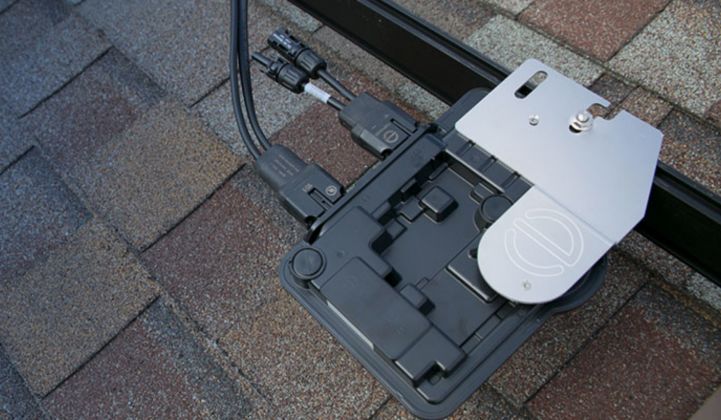Enphase reported first quarter 2018 earnings that hit the high end of analyst expectations, along with news that its latest microinverter technologies are rolling out to partners in the U.S. and its CFO is resigning at the end of next month.
The Petaluma, Calif.-based company reported revenue of $70 million for the first quarter of 2018, down 22 percent from the previous quarter but up 11 percent from the same quarter last year. It also improved non-GAAP gross margin to 26.5 percent, beating guidance, and reported non-GAAP operating income of $861,000.
“We had a decent quarter,” CEO Badri Kothandaraman, who replaced founding CEO Paul Nahi last year, said in a Tuesday conference call. Importantly, the company ended the quarter with a total cash balance of $53.3 million compared to $29.1 million in the previous quarter.
That cash balance was fed by a $20 million private equity investment in February, but it also included $3.4 million in cash from operations and about $2.3 million in positive free cash flow, Kothandaraman said. That’s an important milestone for a company that’s struggled in the past few years against competition from rival SolarEdge and incumbent string inverter makers such as SMA, Fronius and ABB.
This competition has cut into the company’s market share over the past several years, pushing its shares into sub-$1 territory and forcing it to issue several “going concern” statements in its 2016 earnings reports.
Last year it laid off about 18 percent of its workforce, and in June replaced its founding CEO. In February, Enphase reported a 2017 net annual loss of $45,192 (or 54 cents per share) an improvement from a 2016 net loss of $67,462 (or $1.34 per share).
During Tuesday’s conference call, Kothandaraman highlighted Enphase’s efforts over the past year to introduce “discipline and rigor, supported by metrics.” Those efforts range from tightening margins and inventory, to boosting its customer relations performance via metrics like net promoter scores, he said.
Jeffrey Osborne, analyst for Cowen & Co., cited several positive signs in Enphase’s first quarter report, including its improved gross margins “driven primarily by stable pricing, supply chain optimization, and the transition of the IQ 7 platform,” Enphase’s latest technology.
Enphase shipped 611,000 microinverters, or 180 megawatts-DC, about 67 percent of those being its IQ technology. The IQ 7 started rolling out in the U.S. this quarter, and represented about 8 percent its shipments in the first quarter, Kothandaraman said.
In Europe, where Enphase’s first-quarter revenue was up 11 percent from the previous quarter and 92 percent year-over-year, the IQ 7 is now available in the U.K., and the company expects to introduce it in Germany and Austria along with other European countries during 2018, he said. “We maintained our market share lead in France during the first quarter and grew market share in the U.K., the Benelux [region] and Switzerland.”
In the Asia-Pacific region, revenue increased 5 percent from the previous quarter and 88 percent year-over-year, marking Enphase’s largest quarter ever for shipments to the region, he said. Other key markets include India, where Enphase recently announced availability of its IQ microinverters, and Latin America, where first-quarter revenue increased about 32 percent from the previous quarter, driven by investment into rebuilding Puerto Rico’s energy infrastructure.
Kothandaraman conceded that component shortages have hampered the IQ 7 rollout, adding, “We are working diligently to resolve the issue.” But the company estimates that the product could open a “gigawatt of new market opportunity,” he said, representing a roughly 20 percent increase to its served available market.
Enphase’s next line of microinverters, the IQ 8, is still in development, with an expected launch in the fourth quarter of 2018 for off-grid applications targeting Africa, India and Latin America. Unlike the rest of its inverters, the IQ 8 platform is designed to support both grid-tied and off-grid applications, supported by the company’s Ensemble software.
Kothandaraman also highlighted Enphase’s work on AC modules — solar panels embedded with microinverters to deliver household and grid-ready alternating current. Last month, Enphase landed its third AC module partner, Solaria, which plans to have an AC module available by June 2018.
Enphase’s first partner, LG, started selling AC modules in July 2017. In February, Enphase announced it was working with Panasonic to integrate into its 330-watt HIT modules. According to a recent survey of installation partners, AC modules have led to “installation time savings up to 20 percent, logistics savings up to 10 percent and simpler inspection procedures” compared to standard direct current modules, Kothandaraman said.
CFO Bert Garcia, who is retiring as of June 30, took a moment on Tuesday’s conference call to thank the company, its partners and customers for his eight years working at Enphase. Garcia replaced Kris Sennesael as CFO in June 2016.
Cowen & Co.’s Osborne noted that, “with Mr. Kothandaraman being relatively new as CEO, we view this transition as an opportunity for him to focus on building his own team now that the restructuring is largely done and the product cycle roadmap has begun to play out.”
Osborne also wrote that whoever is picked as new CFO will face the early task of managing Enphase’s term loan facility with Tennenbaum Capital Partners, which it increased from $25 million to $50 million early last year.




